We’re in an age where everything seems to be quantifiable, whether it’s page views or Facebook likes or Twitter shares or how many people showed up for an event.* Or at least there are a lot of people and organizations out there that feel the need to quantify what we produce, what impact we’re having. This is not a bad thing necessarily, especially not when it comes to social campaigns or advocacy projects.
So is it elitist to want art to exist on a plane that’s different from the “quantifiable”? I’m not even speaking about the art for art’s sake idea – for art can indeed be a tool for social activism – but also from the standpoint of personal connection and exposure.

Zanele Muholi (South African, born 1972). Faces and Phases installed at dOCUMENTA (13), Kassel, Germany, 2012. (Photo: © Anders Sune Berg)
Lately, I’ve been devoting a lot of time to lectures, exhibits, and cultural exploration and it made me realize something. Aside from enjoying what I’m seeing and being inspired by different perspectives, I’m continuously learning about the world around me. It’s the comment that makes me think about something in a different way, or a series of photographs that evokes someone else’s state of mind, or a film that reveals to me that there’s a subculture within a subculture within another culture that I didn’t even know about.
And I think that’s one aspect of how art can connect us to what’s outside ourselves, and sometimes even make us realize what we never thought of as being inside ourselves.
Continue reading

